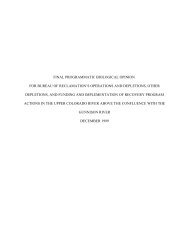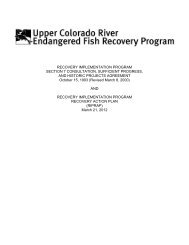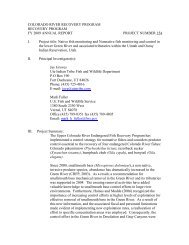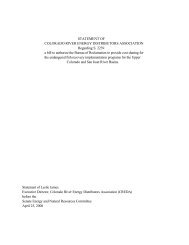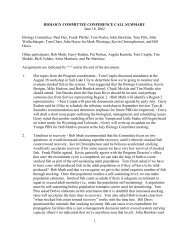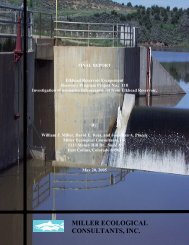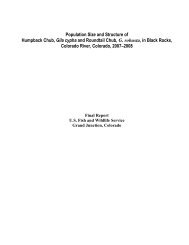K. R. Bestgen, K. A. Zelasko, and G. C. White. Monitoring ...
K. R. Bestgen, K. A. Zelasko, and G. C. White. Monitoring ...
K. R. Bestgen, K. A. Zelasko, and G. C. White. Monitoring ...
You also want an ePaper? Increase the reach of your titles
YUMPU automatically turns print PDFs into web optimized ePapers that Google loves.
LIST OF FIGURES<br />
Figure 1. Colorado River Basin with Upper Colorado River study area.......................................64<br />
Figure 2. Number of razorback sucker larvae captured in light trap samples the middle <strong>and</strong><br />
lower Green River, Utah, 1993–2010................................................................................65<br />
Figure 3. Map of razorback sucker larvae captures, middle <strong>and</strong> lower Green River, in two time<br />
periods, 1993–1999 (left panel), <strong>and</strong> 2000–2010 (right panel).........................................66<br />
Figure 4. Concentrations areas of juvenile <strong>and</strong> adult razorback suckers (mean TL = 332 mm,<br />
203–505 mm) captured in the Green River, Utah..............................................................67<br />
Figure 5. Concentration areas of juvenile <strong>and</strong> adult razorback suckers captured from river mile<br />
120–95 in the lower Green River, Utah.............................................................................67<br />
Figure 6. Percent macrohabitat use by razorback suckers captured in the downstream (RM 94.9–<br />
0, left panels) <strong>and</strong> upstream ((RM 120-90, right panels) sections of the lower Green<br />
River, Utah.........................................................................................................................68<br />
Figure 7. Percent macrohabitat use by primary habitat type for razorback suckers captured in the<br />
Desolation-Gray Canyon reach of the Green River, Utah.................................................69<br />
Figure 8. Concentration areas of juvenile <strong>and</strong> adult razorback suckers captured from river mile<br />
320–300 in the middle Green River, Utah.........................................................................70<br />
Figure 9. Percent macrohabitat use by razorback suckers in the downstream (RM 299.9-246.1,<br />
left panels) <strong>and</strong> upstream (RM 320–300, right panels) sections of the middle Green River,<br />
Utah....................................................................................................................................71<br />
Figure 10. Abundance of juvenile <strong>and</strong> adult razorback suckers captured in the Colorado River,<br />
Colorado <strong>and</strong> Utah, during sampling for Colorado pikeminnow abundance<br />
estimation...........................................................................................................................72<br />
Figure 11. Percent macrohabitat use by razorback suckers captured in the downstream (RM<br />
124.9–0, left panels) <strong>and</strong> upstream ((RM 185–125, right panels) sections of the Colorado<br />
River...................................................................................................................................73<br />
Figure 12. Simulation results that depict the bias (positive or negative) of abundance estimates<br />
under different scenarios of probabilities of capture per pass...........................................74<br />
Figure 13. Simulation results that depict the precision (as % coefficient of variation,<br />
[SE/estimate]*100) of abundance estimates under different scenarios of probabilities of<br />
capture................................................................................................................................75<br />
Page<br />
6



